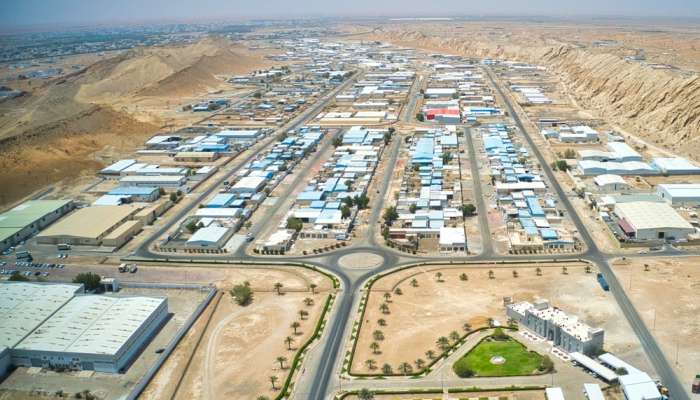
Muscat: The Public Authority for Special Economic Zones and Free Zones (OPAZ) has begun developing new industrial cities as part of its plan to increase the number of industrial establishments, localize investments in the industrial sector, boost the sector’s contribution to the gross domestic product, and create more job opportunities for Omani youth.
The industrial areas currently being developed by the Authority, in collaboration with the Public Establishment for Industrial Estates (Madayn), include Mahas Industrial City in the Wilayat of Khasab, Musandam Governorate, where an agreement for road and infrastructure development was signed in October last year. Additionally, Al Mudhaibi Industrial City witnessed the signing of an agreement for the localization of its first projects in the last quarter of the previous year. The tender for the construction of basic infrastructure for the first phase of the city has been floated for specialized companies in the Sultanate of Oman and Kingdom of Saudi Arabia, allowing participation through an Omani-Saudi consortium.
Last year also saw the completion of the consultancy services project for the design and supervision of the construction of Thumrait Industrial City in Dhofar Governorate, as well as the completion of the consultancy services project for the master plan of Seeh Al Sarya Industrial City.
Furthermore, the consultancy services contract for designing the master plan and detailed design of Madha Industrial City (Seih Al Wasat) was awarded. The tender for consultancy services for the design and supervision of Al Suwaiq Industrial City in Al Batinah North Governorate has also been floated, while procedures are underway to issue the consultancy services tender for Al Wadi Al Kabir Industrial City in Muscat Governorate. Additionally, coordination is ongoing with the authorities concerned to allocate land for Shinas Industrial City in Al Batinah North Governorate.
The development of new industrial cities comes amid significant activity in special economic zones and free zones, which saw the number of industrial licenses rise to 183 by the end of 2024 across various regions of the Sultanate of Oman. Industrial cities accounted for the largest share of this growth, with 125 licenses issued, representing 68 per cent of the total licenses across all zones supervised by the Authority.
This growth reflects the increasing attention given to the industrial sector in Oman and the incentives provided by OPAZ to encourage investment in the sector. The special economic zones, free zones, and industrial cities under the Authority’s supervision offer numerous investment opportunities that support industrial development and contribute to achieving the objectives of the Industrial Strategy 2040. This strategy, approved by the Council of Ministers last year, aims to drive economic diversification, enhance the quality of Omani industrial products, and establish a modern manufacturing base driven by technology.
The zones under the Authority’s supervision are well-known for their supportive infrastructure for the industrial sector, including investment-ready land, diverse spaces accommodating heavy, medium, and light industries, and essential infrastructure. Many of these zones also have access to natural gas, investment incentives, tax and customs exemptions, and other facilities. Additionally, they are well connected to a network of ports and airports, facilitating the export of products and the import of raw materials.
In recent years, industrial investment in special economic zones, free zones and industrial cities has grown significantly, positively impacting the national economy by increasing the local added value of domestic industries and creating more job opportunities for Omani youth in the industrial sector.
OPAZ focuses on increasing industrial sector investments to enhance the added value of local industries and utilize domestic raw materials in establishing new investment projects that generate more job opportunities for young Omanis. The Authority also emphasizes encouraging innovation in the industrial sector, integrating technology into various industries, and ensuring the sustainability of the sector by preserving the environment and reducing emissions.
Over the years, the economic and free zones, along with industrial cities, have made significant efforts to diversify their industrial base, resulting in an increase in the number of industrial establishments. Currently, 2,012 manufacturing establishments operate across various zones under the Authority’s supervision, covering a wide range of industries, including food production, bus manufacturing, pharmaceuticals, veterinary products, textiles, ceramics, construction materials, petrochemicals, iron and metal industries, plastics, packaging, water production, and more. Micro-enterprises make up the largest share, accounting for 65 per cent of these establishments. These industries collectively employ over 42,000 Omani and expatriate workers, with Omanisation reaching 24 per cent of the total workforce in the sector.
The Special Economic Zone at Duqm (SEZAD) is one of the key industrial investment hubs, hosting the Duqm Refinery, the crude oil storage terminal, and facilities supporting the growth of green industries and fisheries-based industries.
The Public Establishment for Industrial Estates (Madayn) provides numerous investment opportunities in the industrial sector across all its industrial cities. Over the past years, Madayn has successfully attracted investments in building materials, food industries, chemicals, pharmaceuticals, and metal and plastic manufacturing.
In Al Mazunah Free Zone, the import and export sector is one of the most prominent investment areas, benefiting from its geographical proximity to the Republic of Yemen. In recent years, investors have increasingly focused on food industries, water production, packaging, and other industries.
The Salalah Free Zone is home to various investments in pharmaceuticals, petrochemicals, mining, and food industries. Meanwhile, the Sohar Free Zone has established itself as a hub for leading industrial projects in the mining sector, pharmaceuticals, veterinary products, textiles, ceramics, and construction materials.